MSI B85M ECO Review: Aiming Green at $73
by Ian Cutress on November 26, 2014 8:00 AM EST- Posted in
- Motherboards
- MSI
- B85
- ECO
MSI B85M ECO Software
MSI’s big play in the software space is their ECO Center Pro software. We have come across ECO software on MSI’s products before, but this extends the idea into as many ports as possible.
The lightning bolt shows an item that is powered, and deselecting the item then clicking apply will turn off that port or LED. Some features need a reboot to work, and it might not be advised to disable the CPU fan completely. In a similar vein, disabling the HDMI/DVI/D-Sub is a bad idea when on integrated graphics. If there is ever an issue, a user can use the ClearCMOS header on the motherboard to get back to default.
At the top right of this menu are three modes: ECO, Lounge and Server. MSI recognizes that this sort of motherboard might be used as HTPC/Server duties, and provides a series of presets. The ECO mode option is similar to that given by the onboard button or the BIOS options.
A lot of the CPU power management features are also part of ECO Center Pro, allowing users to select cores, C-states and power limits. One option here interests me – the LakeTiny feature. This is an option for a set of SSD enhancements that came with Intel's 8-series when RST is enabled.
The Hardware Monitor part of the software is similar to the BIOS fan controls, giving control over two of the fan headers as well as a series of temperature and voltage readings.
Along with ECO Center Pro, MSI gives an install option as part of the driver disk to include an ECO edition background. I really think the shade of green used in this approach works well for MSI. It seems to go with a lot of their design characteristics.
As part of the package, MSI bundles in Intel’s Extreme Tuning Utility (XTU). What intrigued me about this software is the ‘overclocking’ options.
One of my previous points in this review was the inability to reduce voltage and save power. XTU has an option relating to voltage, but you can only increase it. So close!
Due to B85 being part of the Intel Small Business Advantage program, this software also comes bundled on the disk to allow admins to keep track of the systems under their control.
MSI also includes fast boot options, which in our case did not seem to boost the system POST time much. The Go2BIOS function restarts the system straight into the BIOS, should anything need changing there.
The jewel in MSI’s regular software lineup is Live Update 6 which will examine the drivers and software on your system and compare it to an online database with up-to-date versions. If different, LU6 will suggest the download and installation. MSI has worked to improve this software over recent months, such as stating the size of the download before deciding what to install. The download procedure also shows the per-software install progress, rather than putting everything together.



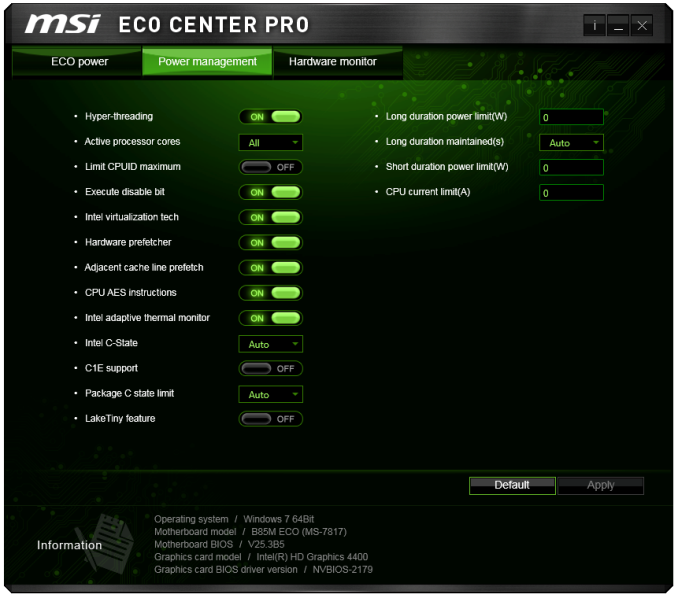


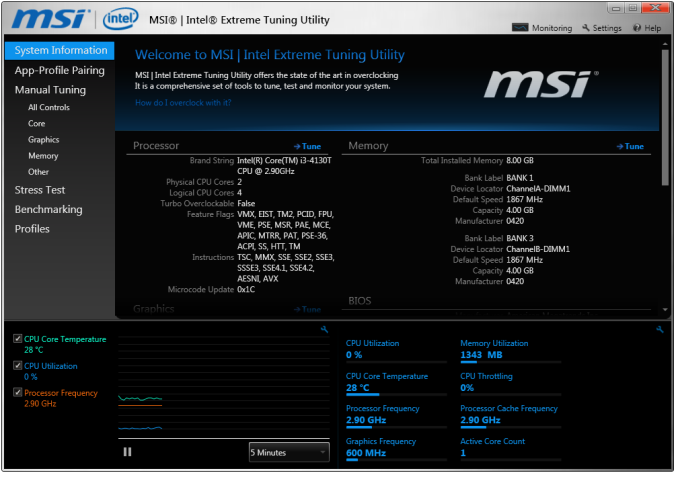
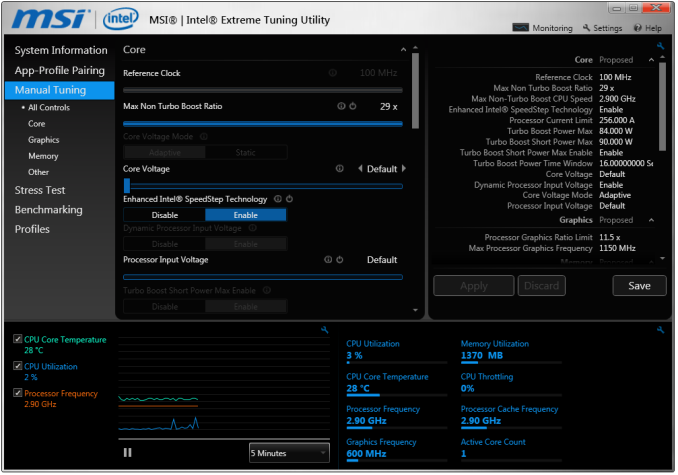
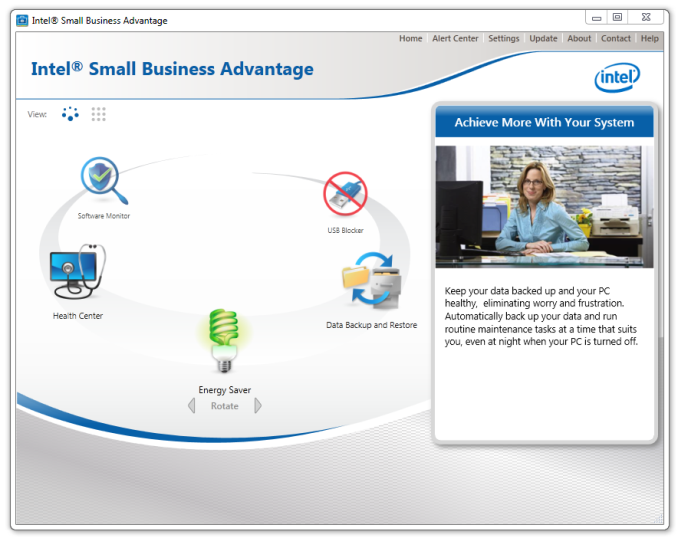


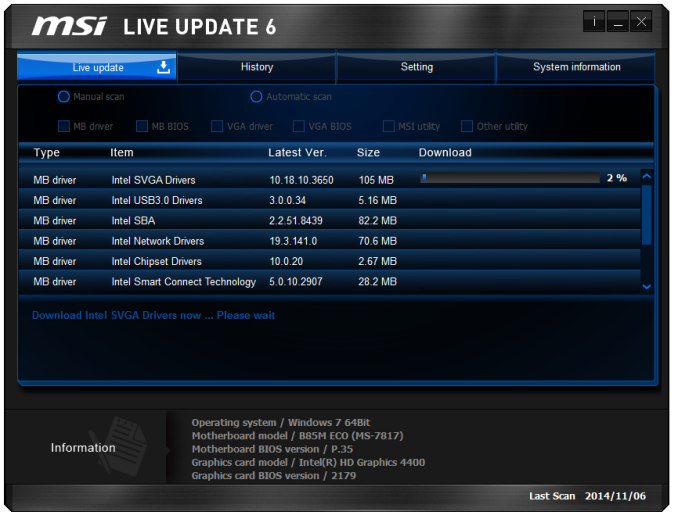














40 Comments
View All Comments
Cygni - Wednesday, November 26, 2014 - link
A Mini-ITX ECO would be right in my wheelhouse.I have an HTPC/NAS/Steam Mini-ITX thats on 24/7 and is several years old. It's next replacement cycle would likely last 5+ years, and the lowered power draw (plus lower heat) would be a no brainer over that lifetime. Could also see a market for personal servers and the like in Mini-ITX.
I would echo the request for undervolting access, even if its rarely worth it. The option would be appreciated to tinker with, if nothing else.
PaulJeff - Wednesday, November 26, 2014 - link
I think the point of these "eco" boards is determined by the economy of scale. For a real world example, you would need to replace dozens if not hundreds of workstations/desktops in an office to realize the true savings potential. If one workstations nets a few dollars a year in savings on power costs, multiply that by the number of workstations that will be replaced, multiply that by the # of years between hardware refresh cycles and that will add up the potential power savings.MSI should be selling this "ECO" brand to OEMs like Dell, HP, etc. and then the savings can be distributed on a mass market scale.
The cost delta between a non-ECO branded board and an ECO board is not worth it for SMB's and home users.
ultimatexbmc.com - Wednesday, November 26, 2014 - link
Good priceDaiz - Wednesday, November 26, 2014 - link
The price of electricity does not take into account the true cost of it's generation.It might be good to also consider the amount of fuel that is required or carbon output
for example 1kWh of electricity requires ~0.5kg of coal and produces ?? kg of carbon dioxide.
so assuming a 5 year upgrade cycle is going to happen no matter what, you are still stopping ~27.5kg of coal from being burned each year or 137.5kg over the life of the mobo. multiple by the number of machines in an office and every little bit helps.
Conficio - Wednesday, November 26, 2014 - link
Should the energy savings and cost savings not also include the cost for air conditioning/cooling? I know that server rooms care about that. So there should be at least some back of the envelope numbers which should increase the amount of savings somewhat.I'm just curious.
Lerianis - Thursday, November 27, 2014 - link
One thing I wanted to point out: 300 Watt power supply? Eh eh...... even a bargain basement, non-gaming intended dicrete graphics card needs 400 Watts minimum, unless it is the REALLY cheap ones sold to HP/Dell/Gateway for their office PC's.A regular person cannot even order one of those unless they go online and 'lie' to the HP parts person telling them "Yeah, my video card died and I want to replace it myself, can I order one of your replacement discrete graphics cards?"
400 Watts is a more realistic minimum for a system with a discrete graphics card, though with the new integrated graphics from Intel being able to push HD 1080p and 1920*1080 resolution other content without a stutter while using less than 2% of the CPU's power on an i5..... they might have an argument that no one needs a discrete graphics card who is not an uber-gamer anymore.
KAlmquist - Friday, November 28, 2014 - link
Actually, a 300 watt power supply should be enough to power a single GTX 980. However, Ian was presumably thinking about the standard business PC, which uses integrated graphics these days. As you correctly note in your last paragraph, the primary market for discrete graphics cards is now gamers.jtd871 - Thursday, December 4, 2014 - link
Ian,Thanks for reviewing a non-flagship board. Like others who have commented here, I could see something like this finding a home in a future personal build for productivity, light engineering and moderate gaming. And it's $25 to $50 less than the Z-series boards. Please, more like this in the uATX and mITX form factors!
Some feedback for MSI (and other board OEMs): ditch the (non-express) PCI already, please? Any business willing to buy enough of these isn't going to stick PCI add-in boards inside (assuming they can still find drivers for use with their modern operating systems). I would suggest eliminating the PCI slot altogether and keeping the x16 slot separated from the other 2 PCIe slots, as a lot of even low-end GPU cards (for business multi-monitor, say) are at least a double-slot width - rendering the 2nd slot unusable in those situations anyway, and make at least 1 of the remaining slots at least physically x8.
azazel1024 - Thursday, December 11, 2014 - link
This seems like a really stupid test of the power efficiency since that is the main focus. A REAL PSU, like a bronze or higher rated PSU in the 350-500w range should have been used. Either a standard B85, or H85/7 or something should have been compared to it. you have a board with an over abundance of features versus one bereft.Otherwise it is apples to oranges.
Also, if MSI's claims are accurate, the ECO frankly sucks. My Sever with a G1610 in it, H67, 8GB (2x4GB) G.Skill Sniper@1.2v, SSD, 2 HDDs plugged in and a pair of Intel Gigabit CT NICs and Antec Earth Watts 380 burned 21w at idle, drives spun down. The ENTIRE system uses less than what MSI claims a typical uATX boards uses at idle. Based on Intel's numbers for some things like the NICs, I have to assume that the board is using at MOST 15w and probably closer to 12w.
Seems like at most we are talking 2-3w of power savings MAYBE comapred to a VAGUELY similar board.
know of fence - Monday, March 2, 2015 - link
Being an enthusiast site AT always played down power consumption numbers. But just making assumptions and low balling 4 different variables (price, hours, efficiency, years of operation) is both cumbersome and somewhat disingenuous.A more elegant way would be to create a realistic range for those variables and combine them into coefficients for min, max and typical scenarios. You could even do typical US, typical EU, UK, India or whatever.
For me every 1 W saved 24/7 equals 2 EUR/annum, also 66 cent per Watt per year assuming 8 hours a day operation. Not to mention that PCs actually last anywhere from 5 to 10 years, though they are much less frequently used, once they are handed down to relatives.